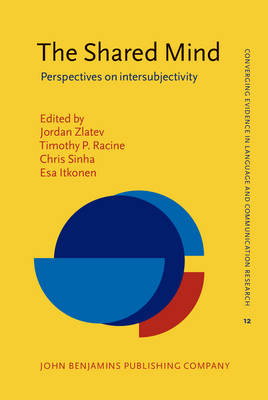
The Shared Mind
John Benjamins Publishing Co (Verlag)
978-90-272-3900-6 (ISBN)
The cognitive and language sciences are increasingly oriented towards the social dimension of human cognition and communication. The hitherto dominant approach in modern cognitive science has viewed “social cognition” through the prism of the traditional philosophical puzzle of how individuals solve the problem of understanding Other Minds. The Shared Mind challenges the conventional “theory of mind” approach, proposing that the human mind is fundamentally based on intersubjectivity: the sharing of affective, conative, intentional and cognitive states and processes between a plurality of subjects. The socially shared, intersubjective foundation of the human mind is manifest in the structure of early interaction and communication, imitation, gestural communication and the normative and argumentative nature of language. In this path breaking volume, leading researchers from psychology, linguistics, philosophy and primatology offer complementary perspectives on the role of intersubjectivity in the context of human development, comparative cognition and evolution, and language and linguistic theory.
1. Foreword. Shared minds and the science of fiction: Why theories will differ (by Trevarthen, Colwyn); 2. 1. Intersubjectivity: What makes us human? (by Zlatev, Jordan); 3. Part I. Development; 4. 2. Understanding others through primary interaction and narrative practice (by Gallagher, Shaun); 5. 3. The neuroscience of social understanding (by Barresi, John); 6. 4. Engaging, sharing, knowing: Some lessons from research in autism (by Hobson, R. Peter); 7. 5. Coming to agreement: Object use by infants and adults (by Rodriguez, Cintia); 8. 6. The role of intersubjectivity in the development of intentional communication (by Brinck, Ingar); 9. 7. Sharing mental states: Causal and definitional issues in intersubjectivity (by Susswein, Noah); 10. Part II. Evolution; 11. 8. Evidence for intentional and referential communication in great apes? (by Pika, Simone); 12. 9. The heterochronic origins of explicit reference (by Leavens, David A.); 13. 10. The co-evolution of intersubjectivity and bodily mimesis (by Zlatev, Jordan); 14. 11. First communions: Mimetic sharing without theory of mind (by Hutto, Daniel D.); 15. Part III. Language; 16. 12. The central role of normativity in language and linguistics (by Itkonen, Esa); 17. 13. Intersubjectivity in the architecture of language system (by Verhagen, Arie); 18. 14. Intersubjectivity in interpreted interactions: The interpreter's role in co-constructing meaning (by Janzen, Terry); 19. 15. Language and the signifying object: From convention to imagination (by Sinha, Chris); 20. Author index; 21. Subject index
| Reihe/Serie | Converging Evidence in Language and Communication Research ; 12 |
|---|---|
| Verlagsort | Amsterdam |
| Sprache | englisch |
| Maße | 164 x 245 mm |
| Gewicht | 870 g |
| Themenwelt | Geisteswissenschaften ► Philosophie ► Sprachphilosophie |
| Geisteswissenschaften ► Sprach- / Literaturwissenschaft ► Sprachwissenschaft | |
| ISBN-10 | 90-272-3900-2 / 9027239002 |
| ISBN-13 | 978-90-272-3900-6 / 9789027239006 |
| Zustand | Neuware |
| Haben Sie eine Frage zum Produkt? |
aus dem Bereich


